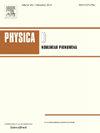On the conservation of helicity by weak solutions of the 3D Euler and inviscid MHD equations
IF 2.9
3区 数学
Q1 MATHEMATICS, APPLIED
引用次数: 0
Abstract
Classical solutions of the three-dimensional Euler equations of an ideal incompressible fluid conserve the helicity. We introduce a new weak formulation of the vorticity formulation of the Euler equations in which (by implementing the Bony paradifferential calculus) the advection terms are interpreted as paraproducts for weak solutions with low regularity. Using this approach we establish an equation of local helicity balance, which gives a rigorous foundation to the concept of local helicity density and flux at low regularity. We provide a sufficient criterion for helicity conservation which is weaker than many of the existing sufficient criteria for helicity conservation in the literature.
Subsequently, we prove a sufficient condition for the helicity to be conserved in the zero viscosity limit of the Navier–Stokes equations. Moreover, we establish a relation between the defect measure (which is part of the local helicity balance) and a third-order structure function for solutions of the Euler equations. As a byproduct of the approach introduced in this paper, we also obtain a new sufficient condition for the conservation of magnetic helicity in the inviscid MHD equations, as well as for the kinematic dynamo model.
Finally, it is known that classical solutions of the ideal (inviscid) MHD equations which have divergence-free initial data will remain divergence-free, but this need not hold for weak solutions. We show that weak solutions of the ideal MHD equations arising as weak- limits of Leray–Hopf weak solutions of the viscous and resistive MHD equations remain divergence-free in time.
三维欧拉方程和无粘MHD方程弱解的螺旋度守恒
理想不可压缩流体的三维欧拉方程的经典解保持螺旋度。我们引入了欧拉方程涡度公式的一种新的弱公式,其中平流项被解释为具有低正则性的弱解的副积(通过实现Bony副微分微积分)。利用该方法建立了局部螺旋平衡方程,为低规则下的局部螺旋密度和通量的概念提供了严格的基础。我们提供了一个充分的螺旋度守恒判据,它比文献中许多现有的充分的螺旋度守恒判据弱。随后,我们证明了在Navier-Stokes方程的零粘度极限下螺旋度守恒的一个充分条件。此外,我们建立了缺陷测度(局部螺旋平衡的一部分)与欧拉方程解的三阶结构函数之间的关系。作为本文引入的方法的副产品,我们还得到了无粘MHD方程和运动发电机模型中磁螺旋度守恒的一个新的充分条件。最后,已知具有无散度初始数据的理想(无粘)MHD方程的经典解将保持无散度,但这对于弱解不一定成立。我们证明了理想MHD方程的弱解在时间上保持无散度,其弱解产生为粘性和阻力MHD方程的Leray-Hopf弱解的弱- *极限。
本文章由计算机程序翻译,如有差异,请以英文原文为准。
求助全文
约1分钟内获得全文
求助全文
来源期刊

Physica D: Nonlinear Phenomena
物理-物理:数学物理
CiteScore
7.30
自引率
7.50%
发文量
213
审稿时长
65 days
期刊介绍:
Physica D (Nonlinear Phenomena) publishes research and review articles reporting on experimental and theoretical works, techniques and ideas that advance the understanding of nonlinear phenomena. Topics encompass wave motion in physical, chemical and biological systems; physical or biological phenomena governed by nonlinear field equations, including hydrodynamics and turbulence; pattern formation and cooperative phenomena; instability, bifurcations, chaos, and space-time disorder; integrable/Hamiltonian systems; asymptotic analysis and, more generally, mathematical methods for nonlinear systems.
 求助内容:
求助内容: 应助结果提醒方式:
应助结果提醒方式:


